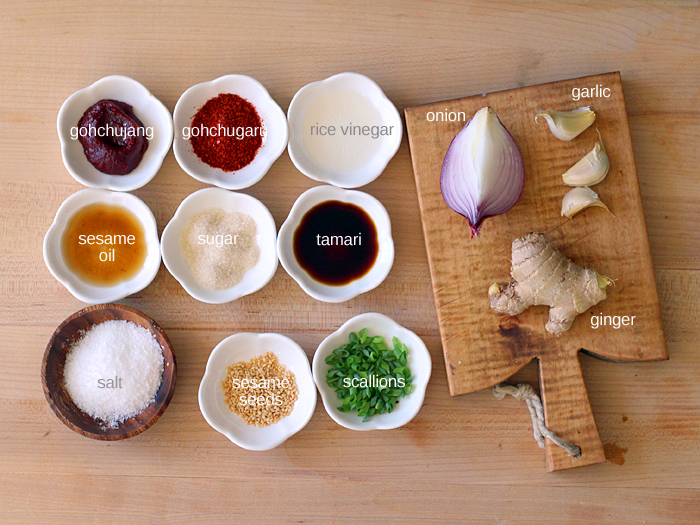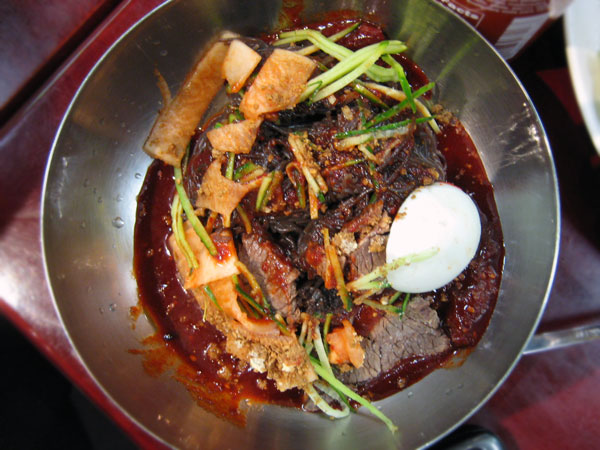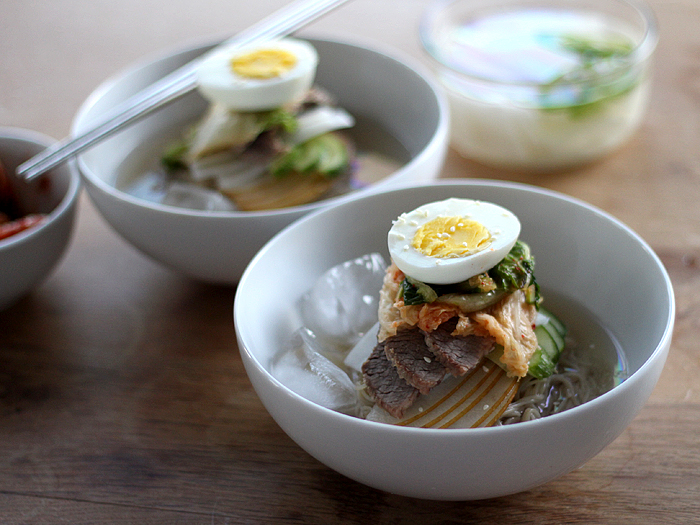Maybe it's a little early in the season to start thinking about Bibim Naeng-Myeon and its cooling effect on the body and mind, at least early for LA, where it's spring year round and only gets cold-noodles-level hot in September.

Jump to:

What is Bibim Naeng Myeon
Bibim Naeng Myeon, sometimes spelled Bibim Neng Myun, is a Korean dish of chewy buckwheat-based noodles and fresh vegetables mixed with a spicy, salty, subtly sweet sauce. In some versions, Bibim Naeng Myeon also includes a chilled, sometimes icy broth that has a refreshing, cooling effect, especially in the high heat and humidity of summer.
Some parts of the word Bibim Naeng Myeon might look familiar. Bibim means "mix," which is in bibim-bap, Korean mixed rice, and bibim-guksu, Korean mixed noodles.
Naeng means "cold," and myeon refers to "noodles." There is also a Korean dish called Naeng Myeon, which is the brothy, no-spice sister of Bibim Naeng Myeon.

Ingredients You Need
- Korean naeng-myeon noodles
- Stock. beef, chicken, mushroom, or omit completely
- Asian pear
- Cucumbers
- Radish
- Eggs
- Toasted sesame seeds
- Green onion
- Gochujang, Korean red pepper sauce
- Gochugaru, Korean red pepper powder
- Soy sauce or tamari
- Sugar, if you can find date sugar, that is great!
- Rice vinegar
- Sesame oil
- Onion
- Garlic
- Salt

What Kind of Noodles for Bibim Naeng Myeon
At the Korean market, you will find naeng-myeon noodles in the Asian noodle aisle or with Asian noodles in the refrigerated section. Many brands sell the noodles in packages along with powdered soup base and serving seasonings, kind of like packaged instant ramen.
Throw these packets out because 1) you don't need soup for Bibim Naeng-Myeon and 2) if you do need soup because you're making Mool Naeng-Myun, make the soup stock from scratch. Or at the very least, semi-scratch.
Naeng-myeon noodles consist primarily of buckwheat, but can also include arrowroot, corn, and sweet potato starches, as well as regular wheat flour. The different combinations will all differ ever-so-slightly in color, taste, and texture from one another. Here are the types of naeng myeon noodles you can look out for:
- Buckwheat "Pyong Yang" style, light grey, sometimes mixed with potato or sweet potato starch to help hold its shape. This type is my favorite.
- Buckwheat with sweet potato starch (함흥) "Ham Heung" style, named for the region in Korea where it originates, slightly chewier
- Chik Naeng Myeon (칡 냉면) made with arrorwroot starch, these noodles are darker and much much chewier! I love foods with any kind of texture whether that's crisp, crunchy, or chewy, but personally these are a little too chewy for me.
The only noodles from which you want to differentiate for sure are dang-myun, which are thicker, more transparent like "cellophane," and more slippery and used for jap-chae and other soups and stews; and buckwheat soba, which are "squared off" and not bouncy/chewy.


Ingredients Notes and Resources
- Stock: Beef stock is traditional, but I use homemade chicken bone broth that I keep in my freezer. This brand is in my pantry for emergencies.
- Eggs from Lily's (they're brown, green and blue!), available at Wednesday Santa Monica and Sunday Hollywood Farmers' Markets
- Salt. I use this brand of Kosher salt.
- Korean Radish. Korean radish is much bigger than any regular radish, including the Japanese daikon radish. It is short, stout, and the "skin" is light green at the top. If you cant find Korean radish, Daikon radish is the next best thing, and if you can't find daikon radish, try a turnip! Lightly pickle the radish using this pickle brine recipe.
- Asian pear. Asian pears are the big, round pears with light beige to brown skin. The texture is crisp but not hard, similar to a Honeycrisp apple, slightly sweet, and very refreshing. If you can't find Asian pears, any other crisp, not soft, pear will work.
- Cucumbers. Use any thin-skinned, generally seedless cucumber. I like Persian cucumbers and they are easy to find around me here in Los Angeles. English cucumbers work well, too.
- Roasted Sesame Seeds. Sesame seeds add some texture and when toasted, a layer of umami in addition to the toasted sesame oil. You can buy sesame seeds plain or toasted. Make sure the seeds are toasted. If they are not toasted, toss them in a hot, dry skillet over medium heat for about 90 seconds or until they are fragrant.
Bibim Naeng Myeon Sauce Ingredients
- Gochujang is a Korean hot pepper paste made by fermenting chili peppers with rice and/soybeans. It has a deep-toned, savory umami flavor with a subtle background sweetness. This is the the brand I use, sweetened with tapioca syrup rather than corn syrup, and does not contain wheat in the ingredients
- Gochugaru. Gochugaru is a medium-spicy Korean chili flake or chili powder made from sun-dried chilis. This is the organic brand I use, available online. If you can't find gochugaru, you can substitute cayenne pepper or paprika.
- Rice Vinegar. Make sure to use rice vinegar, and not rice wine which is an alcohol, or mirin, which is a seasoned rice vinegar with salt and sweeteners. I use this organic rice vinegar. This one is available at Whole Foods. If you can't find rice vinegar, apple cider vinegar is a good substitute.
- Soy sauce. Tamari is a Japanese-style soy sauce that is brewed without wheat so it is gluten-free. This is the brand I use, which is also organic. You can use regular soy sauce. If soy is not part of your diet, you can use any of the usual soy sauce substitutes like coconut aminos (vegan) or fish sauce.
- Sugar, if you can find date sugar, that is great!I used organic cane sugar for this round, but I do like Aunt Patty's Organic Date Sugar, available on amazon and at some Whole Foods
- Sesame Oil. Toasted sesame oil is a finishing oil, added to dishes in small amounts just before serving for its flavor, rather than a cooking oil. This is a reliable Japanese brand that I've been using since I was a kid. There are now many brands of toasted sesame seed oil available, even organic versions, at regular grocery stores, like this.
- Onion, Garlic, Ginger, Green Onion and any other herbs and produce from local farmers' markets, Bristol Farms or Whole Foods Market
Frequently Asked Questions and Some Pro-Tips
Recipe Timing Recommendation: If you plan in advance, i.e. know at least the night before that you're going to make/serve/eat bibim naeng-myeon, do two things:
- freeze vinegared light chicken stock into ice cubes for the bowl and
- make the Bibim Naeng-Myeon sauce. All the intense flavors of the sauce ingredients (pictured directly above) can mellow into one another.

Best Bibim Naeng-Myeon Near Me
If you've never eaten naeng-myeon, try it in a restaurant or an experienced Korean cook's kitchen first because the taste, temperature, and texture together is something totally new and different. In cities that have a large Korean population or a designated "Koreatown," there might be restaurants that specialize in naeng-myeon, though many Korean restaurants that specialize in BBQ or a variety of other traditional foods will probably offer naeng-myeon, too.
These are some of the best naeng-myeon restaurants near me in Los Angeles. If you have a recommendation in another city/state/country for naneg-myeon, please do share!
- Yu Chun Chic Naeng-Myun, 3185 W. Olympic Blvd., the OG in LA's Koreatown gets the most, and highest, raves
- Ham Heung Naeng-Myun. 3109 W Olympic Blvd, Los Angeles, CA 90006
- Hangari Kalguksu, 3470 West 6th St Suite 9 & 10, Los Angeles, CA 90020
- Lee Ga, 698 South Vermont Aven, Los Angeles, California 90005. new-ish in Koreatown, with house-made naeng myeon noodles!
- O Jang Dong, 4031 W 3rd St, Los Angeles outpost of a Seoul restaurant that's
Bibim Naeng Myeon Pronunciation
Naeng myun is sometimes spelled as "neng myun" which actually looks closer to the way it's pronounced.
Pronounce bibim like "bee-beem."
Pronounce naeng like "neng."
Myeon is such a weird spelling it actually sounds more like "myun," and yes you do pronounce the Y sound!
Don't let the pronunciation hold you back from making and eating Bibim Naeng Myeon though!


More Chilled Noodle and Noodle Salad Recipes to Beat the Heat
Try these chilled noodle dishes and salads to stay cool:
- Mul Naeng Myun - Korean Chilled Buckwheat Noodle Soup, the soupy, savory sibling to this recipe
- Soba Noodle Salad
- Spicy Soba Noodle Salad with Gochujang Dressing
- Soba Noodles with Miso Tahini Sauce
- Vietnamese-style Rice Noodle Salad
Bibim Naeng Myeon Recipe
Ingredients
Bibim Naeng-Myun Sauce
- ¼ cup goh chu jang Korean red pepper sauce
- 2 tablespoons goh chu ga ru Korean red repper powder
- 2 tablespoons soy sauce or tamari
- 2 tablespoons sugar if you can find date sugar, that is great!
- 2 tablespoon rice vinegar
- 1 tablespoon toasted sesame oil
- ¼ small onion finely minced
- 2 clove garlic finely minced
- 1 teaspoon salt plus more to taste
Bibim Naeng-Myun
- 1 cup stock + 2 tablespoons rice vinegar beef is traditional, chicken and muchroom are perfect. frozen into ice cubes
- ½ lb package Korean naeng-myun noodles
- 1 teaspoon sesame oil
- 1 small Asian pear quartered, cored, and thinly sliced
- 2 Persian cucumbers thinly sliced
- ½ cup vinegar-pickled daikon radish julienned thinly slice daikon radish, pickle using recipe here
- 2-3 hard boiled eggs ½ egg per serving thinly sliced
- 4 tablespoons toasted sesame seeds to garnish
- 1 green onion chopped, to garnish
Instructions
Make Bibim Naneg-Myun Sauce
- Grate the onion, garlic, and ginger on the smallest holes of a box grater, on a microplane, or process into a chunky puree in a food processor.
- Combine onion/garlic/ginger with the remaining ingredients except the salt and additional water. Taste for seasoning and add salt if necessary. If you like the consistency thinner like ketchup rather than thicker like aioli, stir plain water into the Bibim Naeng-Myun sauce ½ teaspoon at a time until you get the consistency you like.
Cook Noodles
- Right before serving, cook the naeng-myun noodles according to the package. Bring water in a large pot to a boil. Turn down the heat to medium and let cook for about 5 minutes. Drain into colander and rinse with cold running water several times while gently "massaging" the noodles.
- Drizzle the rinsed and drained noodles with sesame oil and gently massage the noodles to distribute the oil.
Prep Naeng-Myun Bowls/Serve
- Divide the cooked naeng-myun noodles among serving bowls right away because the noodles are somewhat "sticky" and start to clump together fairly soon (if they are left without liquid/broth).
- Top the noodles in each bowl with 3-4 tablespoons of Bibim Naeng-Myun Sauce — the thick sauce will help to "anchor" the other ingredients on top. Add the julienned Asian pear, cucumber, and slices of half a hard boiled egg.
- Add 2-3 chicken stock ice cubes to the bowls if you're using it. As the stock melts, it will mix with the thicker Bibim-Naeng-Myun red sauce and make it easier to mix the noodles, vegetables and sauce together in the bowl.
- Garnish with toasted sesame seeds and chopped scallions. Serve with additional Bibim Naeng-Myun Sauce, vinegar, and kimchi on the side.








susie says
the best thing at dong il jang is the roast gogi because at the end they do kimchee bokum bbap for you at the table. i used to walk there from my old ktown apartment.
sarah says
oooh, yes, the ro-su (how those silly koreans pronounce it, lol!) gui! i used to be a die hard galbee girl when i was younger - probably because it's sweet. but i am finding now that i prefer the meats without marinades like rosu gui. i loooooove dipping the meat in the sesame oil/salt/pepper sauce. (sam gyup sal is also sans marinade, but it's just waaaay too fatty for my taste).
stef says
i had a craving for korean food today and now i'm reading this...ooops big mistake! now i'm craving it even more. i'm still very new to korean food but i'm learning, thanks to folks like you who share what you know about it ;)
Sarah J. Gim says
I too am learning! There are a lot of traditional dishes I LOVE, and of course, the evolution of the traditional dishes into modern ones as the cuisine spreads and settles into new places with different ingredients!
susan says
i totally agree the best things there is the kimchi fried rice that comes with the rosu gui. totally addicting! and yes it is very very smoky in there.
hermz says
I must visit this place.
Emily says
I believe that corvina is treated with salt, but I'm definitley not any sort of expert on it.
All I know is the little ones have more flavor and are cheaper. I big one (~8-10" long in Korea could easily run $10-$20 at the market, even though it doesn't taste as good and probably weighs around a pound... go figure)
alex says
I am from santa ana but am trying to find a DELICIOUS naeng myun joint in garden grove (little korea), if you can, please help me find a restaurant that serves delicious naeng myun. I would drive to cerritos to eat naeng myun, but that's a 40 minute commute. please help!
Sarah J. Gim says
I think there's a branch of Yu Chun somewhere in Orange County that might be closer to you than Cerritos! Look up YU CHUN!
alex says
my email is [email protected]
thanks!